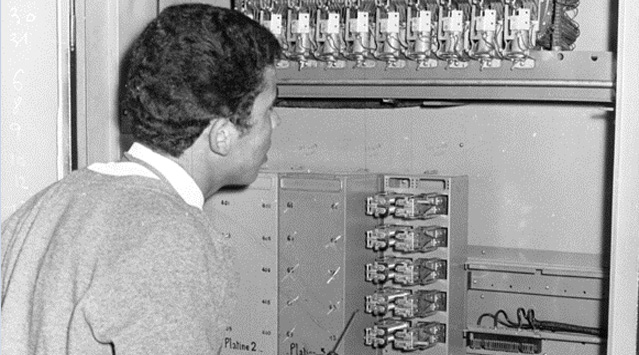AUTOMATIC TELEPHONE EXCHANGES

Electromechanical exchanges
In an automatic system, to control a telephone exchange, all you have to do is operate a dial. In this way you can connect yourself to any telephone in the world.
From the beginnings of the twentieth century, different kinds of electromechanical systems began to substitute the manual work of the operators. The most famous was the Strowger system, which owes its name to its American inventor. Automatic switchboards could establish a connection within the telephone exchange between two subscribers without any human intervention. In order to call a subscriber, you had to press down the keys representing the hundreds, tens and single figures of the number you were trying to connect to. Later, Strowger invented the ten figure telephone dial, a system installed in Rabat in 1927.
Years later, in 1932, the first R6 type switchboard from the American Thomson-Houston company was installed in Casablanca, Fez-Batha and New Fez.
The R6 system uses rotating switches and included a “memory”. Numbers marked on a rotating dial were recorded and memorised before operating the automatic switchboards in the telephone exchange.
It is a device that connects a simple terminal, such as a telephone, or a more complex terminal, such as a computer, with another or several terminals.
Circuit switching includes operations such as making a connection, call management and call control. In addition to call processing (establishing and terminating a connection), switchboards also play a role in billing clients, as well as in operational and maintenance functions.
The command switch within a switchboard is involved in the centralised management of all of these functions. The role of the relationship between switchboards depended on the signalling field.
There are two major types of switchboards, each very different. There are the subscriber switchboards, which are directly connected to subscriber lines and allow linked subscribers to communicate with each other and to access long-distance or international networks.
Then there are the so-called transit switchboards, which do not connect subscribers, but rather connect circuits. Communications within a given area, bound for a distant city, are grouped within the transit switchboard in order to be routed directly to their remote destination.
Automatic telephone exchanges
The more the number of subscribers increases, the bigger the switchboards become and the greater their capacity. As you might imagine, keeping all of this complexity manually operated became increasingly difficult. This led to the invention of mechanical switching systems operated by the subscribers themselves. These systems, known as “automatic exchanges” provided an answer to the saturation of switchboards and operators could concentrate on manual tasks.
These systems made it possible for tasks such as the establishment of the call, after dialling, to be automated. But they also took over maintaining the line active during a conversation, hanging up and freeing the circuit at the end of the call; as well as playing a role in billing the subscriber who had made the call.
Switchboards with Rotary systems
In order to work, they had to use continuously rotating axes. In order to establish a connection between two subscribers, these axes drove line finders around until one selected the customer’s line, then further selectors searched for the line required in a semi-circular field. This system provided a simple procedure by which users could access the telephone network to connect to other subscribers.
These systems were made by the Standard Electric Company. The first was installed in 1949 in Tetouan, in the north of Morocco. It was a model 7-B, the same as those installed later in Chefchaouen and Ksar el-Kebir in 1951, and in Larache in 1952.
Crossbar Switching Exchanges
This name is given to automatic equipment which establishes a connection via multiple input and output contacts, operated by bars, in a matrix or crossed pattern. Its operation was based on an element called a “multi-selector” which, through relays, sent pulses used for ascertaining the necessary crossover points in each case. This system was installed for the first time in the city of El Jadida in 1958, and later in Tetouan, in 1964.
Electronic and digital telephone exchanges
In Morocco, in the last decade of the twentieth century, telephone exchanges were the object of a substantial investment programme. The aim of these renovations was, on the one hand, to replace obsolete equipment and, on the other, to bring about the complete digitalisation of telephone exchanges. This was in response to demands from the population, and above all from the domestic productive sector.
The first digital telephone exchange was installed in the city of Fez in 1976. It was an Alcatel E10A model.
From then on, and above all after 1982, the whole telephone network was changed over to digital switching. This system provided telephonic solutions based on computer technology.
Among the exchanges used in Morocco are the E10 models from French company Alcatel, the AXE from Swedish Ericsson, the DMS from Canadian Northon Telecom and the EWSD from German firm Siemens.
The new generation of switchboards systems, called digital telephone exchanges, today offer many more additional services for the user and, of course, take up much less space for the same quantity of lines.

